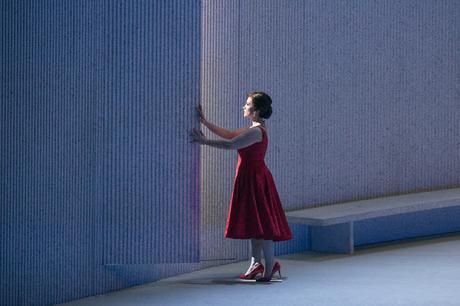by Paul J. Pelkonen

Carmen Giannatasio as Violetta in the Met's La Traviata.
Photo by Marty Sohl © 2017 The Metropolitan Opera.
Violetta herself was sung by Carmen Giannatasio, a compact soprano who unpacked a big instrument over the course of two hours. She sounded unfocused in the opening act, with its couch-surfing Brindisi (a test of balance and singing for any soprano) and its ever more frantic crowd scenes. Slowly, she built up to the big climax of "Sempre libera", and although the notes were present the performance failed to generate the spark needed to put this great aria over the top.
However, a well-placed intermission (there is only one in this show) solved all those matters. Both her voice and performance gelled in the second act, singing the long series of increasingly painful duets with Germont père et fils. Here was the full measure of Violetta, honorable, honest and singing some of Verdi's most tragic music with great form and supple tone. It helped matters that her interactions with Giorgio Germont were more tender than they have been in past runs of this show.
The second half of Act II is not as demanding as the first, but Violetta must hold and control the stage for the entirety of the third act. Here, Ms. Giannatasio's performance elevated to the next level, achieving a biting quality in the big forte moments that was nonetheless pleasing to the ear. She met Verdi's occasionally cruel vocal demands with determination, and when needed a slender core of steel in her tone. The final quartet (carefully led by Nicola Luisotti) impressed the most here, taken at a very slow tempo indeed, with Ms. Giannatasio singing with a quiet control that so few Violettas can manage.
Attala Ayan's Alfredo was less compelling, singing with a grainy tone in the first act. However, his voice acquired freshness and bloom as he warmed up, achieving a near-heroic quality in his Act II double aria. It doesn't help the singers to work against the curved baffle of a set, with its huge gap in the back they must keep their heads forward to be heard in the house. With Mr. Luisotti's careful guidance he achieved a sort of redemption in the last half of the evening, from the nightmarish party sequence to that powerful final quartet.
The best singing of the night came from baritone George Petean. Armed with a warm and supple instrument, he played Germont more sympathetically than in recent years at the Met. This portrayal of the old-school paterfamilias was a welcome surprise, capped by a tender duet with Ms. Giannatasio and a firm and rich "Di Provenza il Mar." In the smaller role of Dr. Grenville, bass James Courtney served double duty as the menacing avatar of Death, present every time something goes sideways with Violetta's health.
This Willy Decker production was innovative when it was first seen in Salzburg. However, it is now ten years old and rapidly wearing out its welcome. Part of the problem is the sheer starkness of the show, without great singers in the core roles it can make a dull evening at a familiar opera even duller. With the Met getting ready to mount a new Traviata in coming seasons, the central visual metaphor of the giant clock seems all too apt. When time runs out for this Traviata, perhaps the opera company will place the timepiece in the Grand Tier.

